Method for realizing multisource multicast traffic balance based on ant colony algorithm
An ant colony algorithm and traffic balancing technology, applied in the field of multimedia communication and network transmission, can solve the problems of insufficient improvement of network resource utilization, increase of average delay and packet loss rate, resource contention, etc.
- Summary
- Abstract
- Description
- Claims
- Application Information
AI Technical Summary
Problems solved by technology
Method used
Image
Examples
Embodiment Construction
[0056] The present invention will be further described in detail below in conjunction with the accompanying drawings and implementation.
[0057] The present invention allows the nodes with idle capacity to provide subflows for other nodes by rationally utilizing the capacity of idle nodes, thereby completing data forwarding, and achieving the purposes of reducing average link delay, average packet loss rate, and balancing network resources.
[0058] Combined with the invention box below figure 2 , the working process principle of the LDA algorithm designed in the present invention is described. The LDA algorithm includes two main modules: candidate route selection and multicast scheduling. At first, all nodes on the network run the LDA algorithm to implement the routing selection mechanism based on the ant colony algorithm, that is, take the topology of the network as input to update the local routing table and link selection probability, such as Figure 8 In the shown net...
PUM
 Login to View More
Login to View More Abstract
Description
Claims
Application Information
 Login to View More
Login to View More - R&D
- Intellectual Property
- Life Sciences
- Materials
- Tech Scout
- Unparalleled Data Quality
- Higher Quality Content
- 60% Fewer Hallucinations
Browse by: Latest US Patents, China's latest patents, Technical Efficacy Thesaurus, Application Domain, Technology Topic, Popular Technical Reports.
© 2025 PatSnap. All rights reserved.Legal|Privacy policy|Modern Slavery Act Transparency Statement|Sitemap|About US| Contact US: help@patsnap.com



